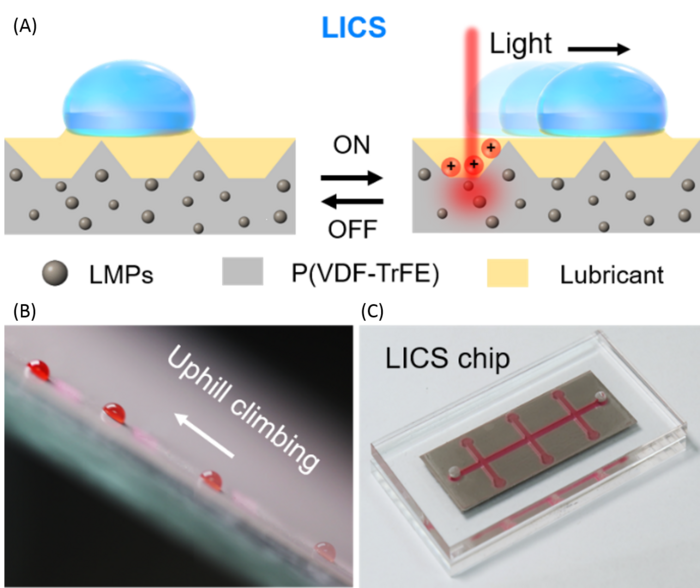A research team led by Dr. DU Xuemin from the Shenzhen Institute of Advanced Technology (SIAT), Chinese Academy of Sciences, has reported a new slippery material with superior light-induced charge regeneration capability, enabling photocontrol of droplets in various working scenarios.

Credit: SIAT
A research team led by Dr. DU Xuemin from the Shenzhen Institute of Advanced Technology (SIAT), Chinese Academy of Sciences, has reported a new slippery material with superior light-induced charge regeneration capability, enabling photocontrol of droplets in various working scenarios.
This work was published in Science Advances on July 8.
Slippery lubricant-infused porous surfaces (SLIPS) and superhydrophobic surfaces have emerged as new interfacial materials for various applications such as self-cleaning, anti-icing, and antifouling. The coverage/screening of the lubricant layer on an underlying rough matrix endows new functionalities that are impossible on superhydrophobic surfaces.
However, such a lubricant layer also brings unwanted issues. First, the presence of the lubricant layer screens the underlying matrix, causing the structural gradient or surface charge gradient normally manifested on the solid surface to become invalid. Second, the existence of lubricant also makes it difficult for active and well-controlled manipulation of the liquid/droplet in a stimuli-responsive manner.
The proposed light-induced charged slippery surface (LICS) consists of three core components, including micro-sized Ga-In liquid metal particles (LMPs) for efficiently converting absorbed light into local heat, poly(vinylidene fluoride-co-trifluoroethylene) [P(VDF-TrFE)] copolymer with excellent ferroelectric behaviour, and microstructures coated with a layer of hydrophobized SiO2 nanoparticles (SiO2 NPs) for trapping lubricant.
Owing to the novel design, the LICS can rapidly generate surface charges as high as 1280 pC mm-2 in 0.5 s under exposure to 100-mW mm-2 near-infrared ray (NIR) irradiation, and its robust charge regeneration capability shows no apparent decay even after being exposed to 10,000 cycles of impulse NIR irradiation, or even immersed with silicone oil for six months.
“The light-induced charge regeneration in LICS exhibits superior efficiency, reliability, and stability, eliminating the unwanted screening effect caused by the presence of lubricant,” said Dr. DU.
The researchers showed that the LICS imparts a new dimension and flexibility to droplet manipulation, such as fast speed (~ 18.5 mm s-1), long distance (~ 100 mm), anti-gravity climbing, single-to-multiple droplets, micro-to-macroscale size (from 10-3 μL to 1.5 × 103 μL), flat-to-curved surface, liquid-to-solid lubricant, and open-to-closed system.
They also extended the LICS to biomedical domains, ranging from specific morphological hydrogel-bead formation in an open environment to biological diagnosis and analysis in pump-free and closed-channel microfluidics.
“The simple design, portable operation, and unique features of the LICS would open new avenues for the next-generation interfacial materials and microfluidics, bringing wide possibilities for chemical and biomedical applications,” said Dr. DU.
Journal
Science Advances
DOI
10.1126/sciadv.abp9369
Article Title
Light-induced charged slippery surfaces
Article Publication Date
8-Jul-2022




